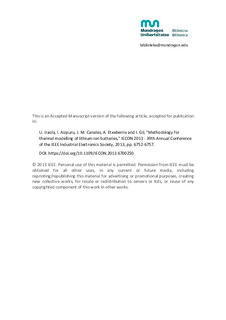Izenburua
Methodology for thermal modelling of lithium-ion batteriesArgitalpen data
2013Beste erakundeak
Orona EICBertsioa
PostprintaDokumentu-mota
Kongresu-ekarpenaKongresu-ekarpenaHizkuntza
IngelesaEskubideak
© 2013 IEEESarbidea
Sarbide irekiaArgitaratzailearen bertsioa
http://doi.org/10.1109/IECON.2013.6700250Non argitaratua
39th Annual Conference of the IEEE Industrial Electronics Society (IECON) 10-13 November. Pp. 6752-6757. IEEE, 2013Argitaratzailea
IEEEGako-hitzak
Mathematical model
Heating
Batteries
Temperature measurement ... [+]
Heating
Batteries
Temperature measurement ... [+]
Mathematical model
Heating
Batteries
Temperature measurement
System-on-chip
Integrated circuit modeling
Solid modeling [-]
Heating
Batteries
Temperature measurement
System-on-chip
Integrated circuit modeling
Solid modeling [-]
Laburpena
Temperature is a determinant parameter in terms of performance, lifespan and safety working with li-ion batteries. Working above 45°C, in hot climates, has direct influence in the cycle life of the ba ... [+]
Temperature is a determinant parameter in terms of performance, lifespan and safety working with li-ion batteries. Working above 45°C, in hot climates, has direct influence in the cycle life of the battery and can cause a dangerous failure if higher temperatures are reached; besides, performance of li-ion batteries in cold climates is very poor due to the high internal resistance they present under these ambient conditions. Being able to predict the temperature of a li-ion cell or the temperature distribution in a module for any working condition without testing the device is considered important when designing energy storage systems based on li-ion batteries. Thus, this paper presents a methodology to achieve the equivalent thermal parameters governing the behavior of a single li-ion cell and the power losses within it; different experimental tests are combined with an analytical expression of the power losses inside a cell to reach this target. The parameters obtained are used to develop a model in matlab/simulink and another model solved with CFD software. Simulation results show good agreement with experimental results with a maximum error of 2°C committed during the validation of the methodology. [-]





















